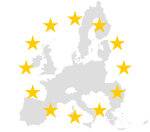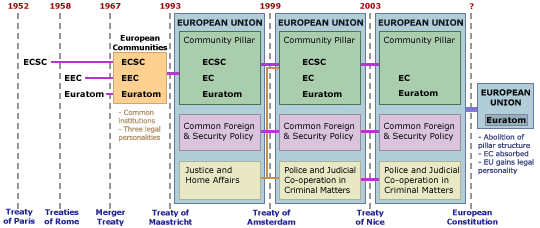Difference between revisions of "European Community (Union)" - New World Encyclopedia
(claimed) |
Laura Brooks (talk | contribs) |
||
| Line 1: | Line 1: | ||
{{Claimed}} | {{Claimed}} | ||
| − | {{ | + | {{Politics of the European Union}} |
| + | |||
| + | The '''European Community''' ('''EC''') was originally founded on [[March 25]], [[1957]] by the signing of the [[Treaty of Rome]] under the name of '''European Economic Community'''. The 'Economic' was removed from its name by the [[Maastricht treaty]] in 1992, which at the same time effectively made the European Community the first of [[three pillars of the European Union|three pillars]] of the [[European Union]], called the '''Community''' (or '''Communities''') '''Pillar'''. | ||
| + | |||
| + | == Community Pillar == | ||
| + | The Maastricht treaty turned the European Communities as a whole into the first of [[three pillars]] of the European Union, also known as the '''Community Pillar''' or '''Communities Pillar'''. In Community Pillar policy areas decisions are made collectively by [[Qualified Majority Voting]] (QMV). | ||
| + | |||
| + | == European Economic Community == | ||
| + | The European Economic Community (EEC) was an organization established by the [[Treaty of Rome]] (25 March 1957) between the ECSC countries [[Belgium]], [[France]], [[Italy]], [[Luxembourg]], the [[Netherlands]], and [[West Germany]], known informally as the Common Market (the Six). The EEC was the most significant of the three treaty organizations that were consolidated in 1967 to form the European Community (EC; known since the ratification 1993 of the Maastricht treaty as the European Union, EU). The EEC had as its aim the eventual economic union of its member nations, ultimately leading to political union. It worked for the free movement of goods, service, labor and capital, the abolition of trusts and cartels, and the development of joint and reciprocal policies on labor, social welfare, agriculture, transport, and foreign trade. | ||
| + | |||
| + | In 1956, the [[United Kingdom]] proposed that the Common Market be incorporated into a wide European free-trade area. After the proposal was vetoed by President [[Charles de Gaulle]] and France in November 1958, the UK together with Sweden engineered the formation (1960) of the [[European Free Trade Association]] (EFTA) and was joined by other European nations that did not belong to the Common Market (the Seven). Beginning in 1973, with British, [[Republic of Ireland|Irish]], and [[Denmark|Danish]] accession to the EEC, the EFTA and the EEC negotiated a series of agreements that would ensure uniformity between the two organisations in many areas of economic policy, and by 1995, all but four EFTA members had joined the European Union. | ||
| + | |||
| + | One of the first important accomplishments of the EEC was the establishment (1962) of common price levels for agricultural products. In 1968, internal tariffs (tariffs on trade between member nations) were removed on certain products. | ||
| + | |||
| + | ==The future of the European Communities== | ||
| + | The signed but unratified [[European Constitution]] would merge the European Community with the other two pillars of the European Union, making the European Union the legal successor of both the European Community and the present-day European Union. It was for a time proposed that the European Constitution should repeal the [[Euratom]] treaty, in order to terminate the legal personality of Euratom at the same time as that of the European Community, but this was not included in the final version. | ||
| + | |||
| + | ==Timeline== | ||
| + | ''Evolution of the Structures of European Union'' | ||
| + | {{EU-timeline}} | ||
| + | |||
====The European Community within the Union==== | ====The European Community within the Union==== | ||
| Line 17: | Line 37: | ||
| {{EU-timeline}} | | {{EU-timeline}} | ||
|} | |} | ||
| + | ==External links== | ||
| + | *[http://europa.eu/index_en.htm European Union website] | ||
| + | *[http://www.ena.lu?lang=2&doc=18771 Treaty establishing the European Economic Community] European NAvigator | ||
| + | *[http://www.ena.lu?lang=2&doc=26671 History of the Rome Treaties] European NAvigator | ||
| + | *[http://www.europedia.moussis.eu Europedia: Guide to European policies and legislation] | ||
| + | |||
| + | [[Category:History and biography]] | ||
[[Category:Politics and social science]] | [[Category:Politics and social science]] | ||
| − | [[Category: | + | [[Category:Nations and places]] |
| − | |||
| − | |||
Revision as of 21:33, 6 August 2007
| European Union |
 This article is part of the series: |
|
|
| Treaties |
|---|
| Rome · Maastricht (Pillars) Amsterdam · Nice · Reform |
| Institutions |
| Commission
President José Manuel Barroso |
| Parliament
President Hans-Gert Pöttering |
| Council
Presidency: Portugal (Luís Amado) |
| Court of Justice
President · Members First Instance |
| Elections |
| Last election (2004) · 2007 by-election Next election (2009) · Constituencies Parties · Parliamentary groups |
| Related topics |
| States · Enlargement · Foreign relations Law · EMU · Other bodies · Agencies |
The European Community (EC) was originally founded on March 25, 1957 by the signing of the Treaty of Rome under the name of European Economic Community. The 'Economic' was removed from its name by the Maastricht treaty in 1992, which at the same time effectively made the European Community the first of three pillars of the European Union, called the Community (or Communities) Pillar.
Community Pillar
The Maastricht treaty turned the European Communities as a whole into the first of three pillars of the European Union, also known as the Community Pillar or Communities Pillar. In Community Pillar policy areas decisions are made collectively by Qualified Majority Voting (QMV).
European Economic Community
The European Economic Community (EEC) was an organization established by the Treaty of Rome (25 March 1957) between the ECSC countries Belgium, France, Italy, Luxembourg, the Netherlands, and West Germany, known informally as the Common Market (the Six). The EEC was the most significant of the three treaty organizations that were consolidated in 1967 to form the European Community (EC; known since the ratification 1993 of the Maastricht treaty as the European Union, EU). The EEC had as its aim the eventual economic union of its member nations, ultimately leading to political union. It worked for the free movement of goods, service, labor and capital, the abolition of trusts and cartels, and the development of joint and reciprocal policies on labor, social welfare, agriculture, transport, and foreign trade.
In 1956, the United Kingdom proposed that the Common Market be incorporated into a wide European free-trade area. After the proposal was vetoed by President Charles de Gaulle and France in November 1958, the UK together with Sweden engineered the formation (1960) of the European Free Trade Association (EFTA) and was joined by other European nations that did not belong to the Common Market (the Seven). Beginning in 1973, with British, Irish, and Danish accession to the EEC, the EFTA and the EEC negotiated a series of agreements that would ensure uniformity between the two organisations in many areas of economic policy, and by 1995, all but four EFTA members had joined the European Union.
One of the first important accomplishments of the EEC was the establishment (1962) of common price levels for agricultural products. In 1968, internal tariffs (tariffs on trade between member nations) were removed on certain products.
The future of the European Communities
The signed but unratified European Constitution would merge the European Community with the other two pillars of the European Union, making the European Union the legal successor of both the European Community and the present-day European Union. It was for a time proposed that the European Constitution should repeal the Euratom treaty, in order to terminate the legal personality of Euratom at the same time as that of the European Community, but this was not included in the final version.
Timeline
Evolution of the Structures of European Union
| 1951 | 1957 | 1965 | 1992 | 1997 | 2001 | 2009 ? |
| European Coal and Steel Community (ECSC) | ||||||
| Euratom (European Atomic Energy Community) | ||||||
| European Economic Community (EEC) |
European Community (EC) | |||||
| ...European Communities: ECSC, EEC (EC, 1993), Euratom | Justice & Home Affairs |
|||||
| Police & Judicial Co-operation in Criminal matters (PJCC) | ||||||
| Common Foreign and Security Policy (CFSP) | ||||||
| E U R O P E A N U N I O N ( E U ) | ||||||
| Treaty of Paris | Treaties of Rome | Merger Treaty | Treaty of Maastricht | Treaty of Amsterdam | Treaty of Nice | Reform Treaty |
|
"THREE PILLARS" - ECs (ECSC, EEC/EC, Euratom), CFSP, PJCC |
||||||
The European Community within the Union
The term European Communities refers collectively to two entities — the European Economic Community (now called the European Community) and the European Atomic Energy Community (also known as Euratom) — each founded pursuant to a separate treaty in the 1950s. A third entity, the European Coal and Steel Community, was also part of the European Communities, but ceased to exist in 2002 upon the expiration of its founding treaty. Since 1967, the European Communities have shared common institutions, specifically the Council, the European Parliament, the Commission and the Court of Justice. In 1992, the European Economic Community, which of the three original communities had the broadest scope, was renamed the "European Community" by the Treaty of Maastricht.
The European Communities are one of the three pillars of the European Union, being both the most important pillar and the only one to operate primarily through supranational institutions. The other two "pillars" — Common Foreign and Security Policy, and Police and Judicial Co-operation in Criminal Matters – are looser intergovernmental groupings. Confusingly, these latter two concepts are increasingly administered by the Community (as they are built up from mere concepts to actual practice).
If it had been ratified, the proposed new Treaty establishing a Constitution for Europe would have abolished the three-pillar structure and, with it, the distinction between the European Union and the European Community, bringing all the Community's activities under the auspices of the European Union and transferring the Community's legal personality to the Union. There is, however, one qualification: it appears that Euratom would remain a distinct entity governed by a separate treaty (because of the strong controversy the issue of nuclear energy causes, and Euratom's relative unimportance, it was considered expedient to leave Euratom alone in the process of EU constitutional reform).
| Evolution of the structures of the European Union. | |||||||||||||||||||||||||||||||||||||||||||||||||||||||||||||
Treaties, structure and history of the European Union
| |||||||||||||||||||||||||||||||||||||||||||||||||||||||||||||
External links
- European Union website
- Treaty establishing the European Economic Community European NAvigator
- History of the Rome Treaties European NAvigator
- Europedia: Guide to European policies and legislation
